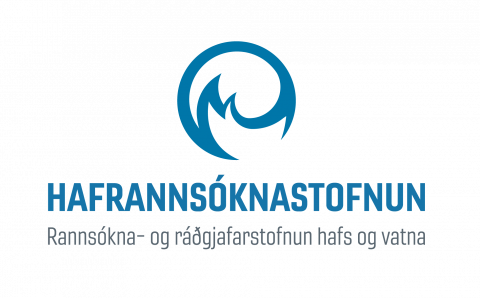- Rannsóknir
- Dýrasvif
- Efnagreiningar
- EU verkefni
- Ferskvatnsfiskar
- Stangveiði
- Fiskmerkingar
- Framandi sjávarlífverur
- Hafsjá
- Hvalarannsóknir
- Kolmunni
- Kortlagning búsvæða
- Kortlagning hafsbotnsins
- Arnarfjörður
- Drekasvæði
- Hali Dohrnbanki
- Ísafjarðardjúp
- Jökulbanki
- Jökuldjúp
- Kolbeinseyjarhryggur og nágrenni
- Kolluáll
- Kötluhryggir
- Langanesgrunn
- Látragrunn
- Nesdjúp
- Reykjaneshryggur og nágrenni
- Selvogsbanki
- Suðaustan Lónsdjúps
- Suðausturmið
- Suðurdjúp
- Suðvestan Jökuldjúps
- Sunnan Selvogsbanka
- Sunnan Skeiðarárdjúps
- Sunnan Skerjadjúps
- Vesturdjúp
- Víkuráll
- Austan við Reykjaneshrygg
- Vestfjarðarmið
- Kvarnir og aldursákvörðun beinfiska
- Loðna
- Makríll
- Myndavélar við stofnmat
- Sjórannsóknir
- Steinbítur & hlýri
- Stofnmælingar
- Veiðarfærasjá
- Vöktun eiturþörunga
- Vöktun veiðiáa
- Þörungarannsóknir
- Ráðgjöf
- Miðlun
- Ársskýrsluvefur
- Fréttir & tilkynningar
- Fyrir skóla
- Lax- og silungsveiðin - tölur
- Málstofa
- Merki/logo
- Myndbönd
- Útgáfa
- YouTube
- Öryggi & persónuvernd
- Um okkur
Peter H. Wiebe flytur erindi á málstofu
07. nóvember 2016
Dr. Peter H. Wiebe vísindamaður emeritus við Woods Hole Haffræðistofnunina í Bandaríkjunum flytur erindi um bergmálsmælingar á lífríki í Norður-Atlantshafi (“North Atlantic High Latitude Acoustic Backscattering”) á málstofu Hafrannsóknastofnunar 10. nóvember kl. 12:30-13:30 í fyrirlestrarsal, 1. hæð að Skúlagötu 4
Rannsóknir Peters lúta að vistfræði dýrasvifs í víðum skilningi. Á meira en 50 ára löngum starfsferli hefur hann m. a. rannsakað stofnvistfræði og útbreiðslumynstur dýrasvifs á stórum og smáum kvarða, flutning lífrænna efna um fæðuvefi sjávar, líf- og vistfræði hringiða í Golfstraumnum, lífríki neðansjávarhvera, stofnstærðarsveiflur og árstíðabundnar breytingar dýrasvifs undan austurströnd Bandaríkjanna og við Suðurskautslandið og líffræðilegan fjölbreytileika. Peter hefur beitt margvíslegri tækni í rannsóknum sínum og verið afkastamikill í þróun nýrra aðferða. Peter hefur hlotið margvíslegar viðurkenningar fyrir störf sín, nú síðast frá Alþjóðahafrannsóknaráðinu á ársfundinum 2016, fyrir framúrskarandi framlag til vísinda (ICES Outstanding Achievement Award).
Í erindinu mun Dr Peter H. Wiebe fjalla um niðurstöður rannsóknaleiðangurs sem farinn var á hafsvæðin vestur og norður af Svalbarða í ágúst og september 2014 þar sem beitt var bergmálsaðferðum til að kanna magn og útbreiðslu átu og fisks.
Hér fer á eftir titill og ágrip erindisins á ensku.
North Atlantic High Latitude Acoustic Backscattering.
Peter H. Wiebe
Scientist Emeritus
Woods Hole Oceanographic Institution
During a SI_ARCTIC cruise aboard the RV Helmer Hanssen west and north of Svalbard in August-September 2014, acoustic data for distribution and abundance estimation of zooplankton and fish were collected with calibrated EK60 echo sounder systems at the acoustic frequencies 18, 38, and 120 kHz. Plankton, miconekton, and fish contributions to the backscattering at 38 kHz were determined by the frequency response, thresholding techniques, and corroborating plankton and trawl data. Typically, there was strong patchy scattering between the surface and about 50 m throughout the area consisting of a range of weak acoustic scatterers like copepods, krill, and amphipods in addition to 0-group fish that were particularly abundant west of the Spitsbergen Archipelago. Off-shelf there was strong deep scattering layer (DSL) between 300 and 500 m containing a range of larger longer lived organisms (mesopelagic fish, shrimps, and various plankton) with a standing biomass likely less variable than for the epipelagial over time. In eastern Fram Strait, the DSL was dominated by fish close to the shelf/slope break that were associated with Warm Atlantic Water moving north towards the Arctic Ocean, but switched to dominance by the plankton/micronekton further offshore. The northward bound organisms in the DSL that have a more southern origin diminished in abundance and taxonomic richness while being transported into the Arctic habitat north of Svalbard. The documented patterns and structures, particularly the DSL and its constituents, will be an important reference point for understanding and quantifying future changes in the pelagic ecosystem of the Arctic Ocean.



